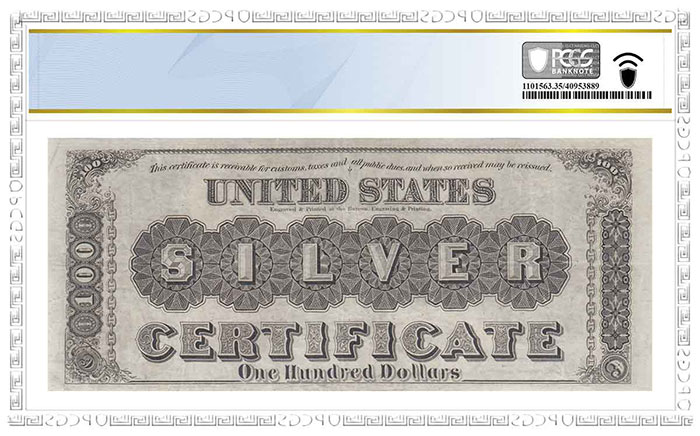By Cory Williams for PCGS ……


Series 1880 “Black Back” $100 Silver Certificate, PCGS Choice Very Fine 35
PCGS recently graded an exemplary specimen of the rare 1880 “Black Back” $100 Silver Certificate, a relic from a time when the United States silver dollar was about to enter a new and colorful chapter of existence. This example was graded Choice Very Fine 35 due to limited circulation and minimal wear, with bright inks remaining, and no problems or distractions rising to the level of needing a grade-qualifying comment on the holder.
Well known in the coin community, the “Bland-Allison Act” of 1878 was the impetus that brought the above silver certificate into existence, with the date of its passage printed vertically at the left end of the banknote. The act required the U.S. Treasury to purchase between $2 and $4 million worth of silver from western U.S. mines every month, convert them into silver dollar coins, and in turn create these banknotes which would now be redeemable in said coins.
Known in the hobby as “Black Backs” due to the reverse being printed in black ink with a dark brown tint (as opposed to the later issues in the traditional dark green), these banknotes were issued in denominations of $10, $20, $50, $100, $500, and $1,000. Having an example of any denomination in a collection is a prize, as they are all quite scarce and in constant demand.
Fifth United States President and “Founding Father” James Monroe is featured prominently at the left of the banknote. Monroe held many positions in his climb to the presidency, including Secretary of War in the administration of President James Madison. Most interestingly, Monroe was a lieutenant in the Continental Army, playing a major part in the Battle of Trenton; nearly dying from a severed artery, he went on to be recognized for bravery by George Washington, who also promoted him to captain. Monroe was also integral in the negotiation of the Louisiana Purchase. Given his long career as an American statesman, it is fitting that he was honored on a piece of American currency.
The facsimile signatures found on this banknote are those of Register of the Treasury William Starke Rosecrans and Treasurer of the United States Enos H. Nebeker. In office from 1891 to 1893, Nebeker served in the Benjamin Harrison and Grover Cleveland administrations. Rosecrans’s tenure as Register of the Treasury from 1885 to 1893 seems like merely a footnote compared to his military career during the United States Civil War. He began as an aide-de-camp to Major General George McClellan, briefly commanding an infantry regiment that included two future U.S. presidents (Rutherford B. Hayes and William McKinley), and became a major general himself.
Given the years that both Rosecrans and Nebeker were in office, this banknote was printed in 1891. That means this issue is a Friedberg #342 (with a known print run of 40,000)–as opposed to the Series of 1891 $100 with the same signatures that was created shortly afterward–and it is a true rarity to behold.
* * *






How much the price PCGS banknotes grade
Rare series of 1880 ” black back” $100 silver certificate
i saw this same note sold for $69,000 in a Heritage Auction, May 7, 2005. Lot #16721.